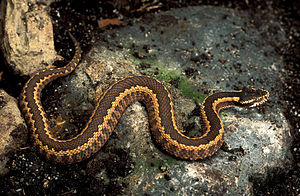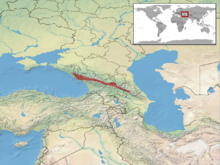Western Caucasus Otter
| Western Caucasus Otter | ||||||||||||
|---|---|---|---|---|---|---|---|---|---|---|---|---|

Western Caucasus Otter ( Vipera dinniki ) |
||||||||||||
| Systematics | ||||||||||||
|
||||||||||||
| Scientific name | ||||||||||||
| Vipera dinniki | ||||||||||||
| Nikolsky , 1913 |
The western Caucasus viper ( Vipera dinniki ), also West Caucasian adder or Dinnikis Caucasus viper , is a species of the real otters ( Vipera ) within the vipers (Viperidae). Their distribution is limited to the western and northern Caucasus and thus connects to the north of the distribution area of the Caucasus otter ( V. kaznakovi ). The scientific name honors the Russian zoologist Nikolai Jakovlevich Dinnik.
features
The western Caucasian viper reaches an average length of about 40 to 55 cm, with the females becoming larger than the males. They resemble the Caucasian viper ( V. kaznakovi ) and the steppe viper ( V. renardi ) in terms of color and shape. The basic color is gray, gray-brown, silver-gray or gray-green with a back drawing made of a broad, dark and sharply defined zigzag or wavy band. The sides of the body are lighter in color and have dark spots that alternate with the drawing on the back. The ventral side is dark gray with light spots. A temple band runs from the temple over the eyes to the corner of the mouth. Occasionally there are completely black, so-called melanistic individuals. Young animals have the same coloration as the adult animals, in melanistic animals the darkening only sets in during ontogenesis .
The head is clearly separated from the rest of the body. The eyes have vertical pupils . On the top of the head, the frontal , parietals and over- eye shields are large. The remaining shields are broken up into small individual scales. About the eye shield forms the rostral a sharp edge, the nostril is surrounded by the nasal . Below the eyes there is a series of under eye shields (subocularia), beneath which are 9 to 11 upper lip shields ( supralabials ). The body scales are keeled. There are usually 21, more rarely 22 to 23, rows of scales around the middle of the body. The under- tail shields ( Subcaudalia ) are divided as in all species of the genus.
distribution and habitat
The western Caucasus otter can only be found in the alpine regions of the western and northern Caucasus from the Fischt - Oschten massif to the Shchara Mountains . The animals prefer mountain forests, mountain meadows, scree slopes and moraines at altitudes between 1500 and 3000 meters as their habitat .
Way of life
The western Caucasus otter is diurnal, whereby the animals can be found on areas exposed to the east in the morning and on areas exposed to the west in the late afternoon, depending on the position of the sun. The hibernation lasts seven to eight months. It feeds mainly on small mammals such as mice and rats as well as lizards and young birds, which it kills with a poison bite. Young snakes feed on grasshoppers and young lizards.
The mating season of the otters begins at the end of April and lasts until May. The snake is viviparous ( oviviviparous ) and gives birth to 3 to 5 young animals that are born from August to September and molt in the first few hours.
Snake venom
The venom of the Western Caucasus Otter is like all Vipera TYPES hemotoxic , medical treatment with an appropriate antivenin is necessary.
literature
- David Mallow, David Ludwig, Göran Nilson: True Vipers. Natural History and Toxicology of Old World Vipers , Krieger Publishing Company, Malabar (Florida) 2003, pp. 285-287, ISBN 0-89464-877-2
- Ulrich Gruber: The snakes of Europe. Franckh'sche Verlagsbuchhandlung, Stuttgart 1989; Pages 198-199. ISBN 3-440-05753-4 .
Web links
- Vipera dinniki in The Reptile Database
- Vipera dinniki inthe IUCN 2013 Red List of Threatened Species . Posted by: Boris Tuniyev, Goren Nilson, Aram Agasyan, Nikolai Orlov, and Sako Tuniyev, 2009. Retrieved September 4, 2013.
